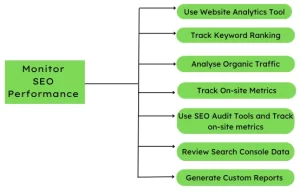Enterprise SEO: Complete Guide to Get Started
Enterprises need SEO to increase their online visibility, drive organic traffic, and enhance their brand’s digital presence. Research shows that 75% of users never scroll past the first page of search results, making enterprise SEO crucial for ranking higher and capturing user attention.
61% of marketers consider improving SEO and organic presence as their top priority for inbound marketing, highlighting the significance of SEO for enterprises.
If SEO has gotten important for almost all the segments, you can read further to know how it can help your enterprises.
What is Enterprise SEO?
Enterprise SEO refers to implementing search engine optimization strategies and techniques tailored explicitly for large-scale businesses or organisations.

- It focuses on optimising companies’ online presence with extensive websites, multiple product lines, numerous locations, or a global reach.
- Enterprise SEO aims to improve the visibility and ranking of these businesses in search engine results pages (SERPs) for relevant keywords and phrases.
- Traditional SEO, enterprise SEO requires a more complex and strategic approach due to the scale and complexity of enterprise websites.
- It involves addressing technical challenges, managing large amounts of content, coordinating with various teams, and implementing SEO strategies across multiple domains or subdomains.
- Enterprise SEO encompasses a wide range of activities, including conducting comprehensive website audits, keyword research and analysis, on-page optimization, technical SEO enhancements, local SEO strategies, building high-quality backlinks, and ongoing monitoring and analysis of SEO performance.
- The ultimate goal of enterprise SEO is to drive organic traffic, increase visibility, and improve conversions for large businesses, helping them establish a robust online presence, reach their target audience effectively, and stay competitive in the digital landscape.
Read: How to do SEO for Small Business?
Importance of SEO for Enterprise Companies
Enterprise SEO analytics gives a scope of improvement to business houses.
SEO is of paramount importance for large-scale businesses and enterprise companies due to the following reasons:
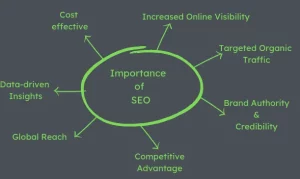
Increased Online Visibility:
With most consumers using search engines to find products and services, having a robust online presence is crucial. Enterprise SEO helps businesses optimise their websites to rank higher in search engine results, making them more visible to potential customers.
Targeted Organic Traffic:
Ranking high in search results for relevant keywords brings targeted organic traffic to enterprise websites. This means attracting users actively searching for the products or services the business offers, increasing the chances of conversions and revenue generation.
Brand Authority and Credibility:
A strong SEO strategy helps establish an enterprise as an authoritative and credible brand. By consistently appearing in top search results, businesses gain trust and recognition from users, leading to enhanced brand reputation and customer loyalty.
Competitive Advantage:
In today’s highly competitive business landscape, enterprises must stay ahead of their competitors. Effective SEO allows businesses to outperform competitors in search rankings, gain a larger market share, and attract customers who may have otherwise chosen their competitors.
Long-Term Cost-Effectiveness:
While SEO requires an initial investment, it offers long-term cost-effectiveness compared to other marketing channels. Once an enterprise website ranks well in search results, it can continue to attract organic traffic without ongoing advertising expenses, resulting in a higher return on investment (ROI).
Localisation and Global Reach:
For enterprises with multiple locations or a global presence, SEO enables targeted localization efforts. By optimising for specific regions or languages, enterprises can effectively reach their target audience in different locations, expanding their customer base and market reach.
Data-Driven Insights:
Enterprise SEO involves tracking and analysing various metrics, such as keyword rankings, organic traffic, and user behaviour. These insights provide valuable data for making informed business decisions, identifying market trends, and refining marketing strategies for better results.
Enterprise SEO Strategy: Best Tips
Here are some best tips for implementing enterprise SEO solutions:
Conduct Comprehensive Keyword Research:
Identify relevant keywords and search phrases that align with your business goals and target audience. To optimise your content effectively, use keyword research tools to discover high-volume and low-competition keywords.
Here are some tips to take care of when conducting keyword research for enterprise SEO:
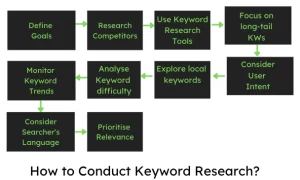
- Define Your Goals: Clearly identify your business objectives and goals for the keyword research process. Determine what you want to achieve, whether it’s increasing website traffic, improving conversions, or targeting specific markets.
- Research Competitors: Analyse the keywords your competitors are targeting and ranking for. This can provide valuable insights into industry trends, gaps in keyword targeting, and potential opportunities to differentiate your enterprise.
- Use a Variety of Keyword Research Tools: Utilise a combination of keyword research tools to gather comprehensive data. Popular tools include Google Keyword Planner, SEMrush, Moz Keyword Explorer, and Ahrefs. These tools can provide keyword suggestions, search volume, competition level, and related keyword ideas.
- Focus on Long-Tail Keywords: Long-tail keywords are more specific and have lower competition. They often have higher conversion potential as they target users with clear intent. Incorporate long-tail keywords into your research to optimise for niche topics and capture highly targeted traffic.
- Consider User Intent: Understand the intent behind search queries and align your keywords accordingly. Determine whether users are looking for information, seeking to make a purchase, or comparing options. Optimise your content to match user intent and provide valuable answers or solutions.
- Analyse Keyword Difficulty: Assess keywords’ competition and difficulty level to determine your ability to rank for them. Look for keywords with a balance of relevance and attainability. Targeting a mix of high-competition and low-competition keywords can help you achieve a well-rounded SEO strategy.
- Explore Local Keywords: If your enterprise has physical locations, incorporate local keywords into your research. Include location-specific terms, such as city names or neighbourhoods, to attract local customers and improve your visibility in local search results.
- Monitor Keyword Trends: Stay updated with industry trends and changes in search behaviour. Regularly analyse and refine your keyword research based on emerging topics, new product launches, seasonal trends, or shifts in user preferences.
- Consider Searcher Language and Semantics: Consider your target audience’s language and terminology when searching for products or services. Incorporate relevant synonyms, variations, and related terms in your keyword strategy to capture a broader range of search queries.
- Prioritise Relevance and Conversion Potential: Choose keywords that are highly relevant to your enterprise and have the potential to drive conversions. Balance search volume with the intent to convert, as attracting qualified traffic is more valuable than simply driving high traffic with low conversion rates.
Ensure your website has a clear, logical structure and easy navigation. Organise content into categories and subcategories, use breadcrumbs and create a user-friendly sitemap to help search engines and users navigate your site.
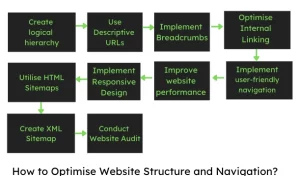
To optimise website structure and navigation for enterprise SEO, follow these best practices:
- Create a Logical Hierarchy: Organise your website content into a logical hierarchy with a clear and intuitive structure. Use main categories, subcategories, and relevant folders to categorise and group related content.
- Use Descriptive URLs: Optimise your URLs to be descriptive and user-friendly. Include relevant keywords in the URL structure to provide search engines and users with an understanding of the page’s content.
- Implement Breadcrumbs: Breadcrumbs provide a hierarchical navigation trail, allowing users to understand their current location within the website. This helps with user experience and makes it easier for search engines to crawl and understand the website structure.
- Optimise Internal Linking: Use internal links to connect related pages within your website. This improves website navigation and helps search engines discover and index content more effectively. Ensure the anchor text of internal links includes relevant keywords when appropriate.
- Implement a User-Friendly Navigation Menu: Create a straightforward and user-friendly navigation menu accessible from every page. Use concise and descriptive menu labels to guide users to different sections of your website.
- Improve Website Speed and Performance: Ensure your website loads quickly and performs well. Optimise images and other media files, minify CSS and JavaScript, enable caching, and use a reliable hosting provider to enhance website speed and user experience.
- Implement Responsive Design: With the increasing use of mobile devices, ensure your website is responsive and mobile-friendly. A responsive design adapts to different screen sizes, providing a seamless user experience across various devices.
- Utilise HTML Sitemaps: Include an HTML sitemap on your website to provide an overview of your website’s structure and facilitate easy navigation. This is useful for users and search engines to locate and access different pages.
- Implement XML Sitemaps: Create and submit XML sitemaps to search engines. XML sitemaps provide a complete list of your website’s URLs, ensuring all pages are indexed and crawled effectively.
- Conduct Regular Website Audits: Regularly audit your website’s structure and navigation to identify any issues or areas for improvement. This includes checking for broken links, optimising anchor text, and ensuring proper redirection for moved or deleted pages.
Create High-Quality and Engaging Content:
Develop informative, valuable, and unique content that aligns with your target keywords and user intent. Use a mix of text, images, videos, and other multimedia elements to engage your audience and encourage social sharing.
If you own an enterprise and wish to have enterprise SEO solutions for content, this is what you can do for high quality and engaging content:
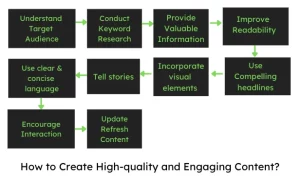
- Understand Your Target Audience: Gain a deep understanding of your target audience’s needs, interests, and pain points. Conduct market research and develop buyer personas to tailor your content to their preferences and requirements.
- Conduct Thorough Keyword Research: Identify relevant keywords and phrases that align with your target audience’s search queries. Incorporate these keywords strategically in your content to improve visibility in search engine results and attract organic traffic.
- Provide Valuable and Unique Information: Create content that offers unique insights, solves problems, or provides valuable information to your audience. Offer a fresh perspective, share industry expertise, or provide actionable tips and advice that resonate with your readers.
- Focus on Readability: Structure your content to be easily readable and scannable. Use headings, subheadings, bullet points, and short paragraphs to break up the text and make it more digestible. Incorporate visuals such as images, infographics, and videos to enhance engagement.
- Use Compelling Headlines and Meta Descriptions: Craft attention-grabbing headlines that entice readers to click and explore your content. Write compelling meta descriptions that accurately summarise your content and encourage users to visit your page.
- Incorporate Visual Elements: Visual content such as images, videos, and infographics can make your content more engaging and shareable. Use visuals that support and enhance your written content, helping convey information visually appealingly.
- Tell Stories and Use Case Studies: Engage your audience by incorporating storytelling techniques and real-life case studies. Use anecdotes, examples, or customer success stories to illustrate your points and make your content more relatable.
- Use Clear and Concise Language: Write clearly and concisely, avoiding jargon or overly technical language that may confuse your audience. Use plain language that is easy for your readers to understand and follow.
- Encourage Interaction and Discussion: Prompt your readers to engage with your content by including calls-to-action (CTAs) such as comments, social sharing buttons, or links to relevant resources. Encourage readers to leave comments or share their thoughts to foster discussion and increase engagement.
- Regularly Update and Refresh Content: Keep your content up to date by periodically reviewing and updating it. This ensures that your information remains accurate, relevant, and valuable to your audience. Additionally, consider repurposing or repackaging existing content in different formats to reach a wider audience.
Implement On-Page Optimisation Techniques:
Optimise your web pages by including relevant keywords in title tags, meta descriptions, headers, and throughout the content. Ensure your content is well-structured, easily readable, and contains internal and external links for better search engine crawling.
Here are the ways in which you can implement on-page optimisation techniques:
To practise on-page optimisation for your enterprise SEO, follow these steps:
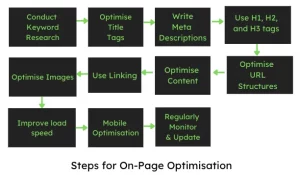
- Conduct Keyword Research: Identify relevant keywords for each page based on your target audience and business goals. Use keyword research tools to discover high-volume and low-competition keywords that align with the page’s content.
- Optimise Title Tags: Craft unique, descriptive, and keyword-rich titles for each page. Keep the title tags concise (around 60 characters) and include the primary keyword or key phrase towards the beginning.
- Write Compelling Meta Descriptions: Create engaging meta descriptions that accurately summarise the page’s content and entice your audience to click. Aim for around 150-160 characters and include relevant keywords to improve click-through rates.
- Use Headers and Subheadings: Structure your content using headers (H1, H2, H3, etc.) and subheadings. This helps readers navigate the content but also assists search engines in understanding the hierarchy and relevance of the information.
- Optimise URL Structures: Create clean and descriptive URLs that include relevant keywords. Avoid long, complex URLs and use hyphens to separate words for better readability and search engine understanding.
- Optimise Content: Ensure your content is optimised for the target keywords. Incorporate keywords naturally in the opening paragraph, subheadings, and body text. However, focus on providing valuable and informative content rather than keyword stuffing.
- Use Internal and External Links: Include links to other relevant pages within your website to help users and search engines navigate and discover related content. Also, include authoritative external links to reputable sources that support and enhance your content.
- Optimise Images: Optimise images using descriptive alt tags and filenames that include relevant keywords. Compress images to reduce file size and improve page load speed.
- Improve Page Load Speed: Optimise your website’s performance by minimising file sizes, enabling browser caching, and using content delivery networks (CDNs). Fast-loading pages improve user experience and search engine rankings.
- Mobile Optimisation: Ensure your website is mobile-friendly and responsive. Optimise page layouts, fonts, and media for different screen sizes to deliver a seamless experience to mobile users.
- Implement Schema Markup: Utilise schema markup to provide additional context to search engines about the content on your pages. Schema markup helps search engines understand and display relevant information in search results, such as ratings, reviews, and product details.
- Regularly Monitor and Update: Continuously monitor the performance of your pages and make necessary updates. Track keyword rankings, organic traffic, and user engagement metrics to identify areas for improvement and optimise accordingly.
Focus on Technical SEO:
Pay attention to technical aspects like website speed, mobile-friendliness, and crawlability. Optimise your website’s performance, compress images, enable browser caching, and fix broken links or redirects.
Here are some tips for implementing technical SEO for your enterprises:
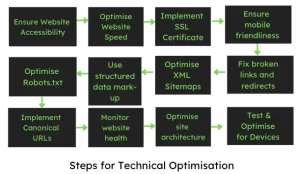
- Ensure Website Accessibility: Ensure your website is accessible to all users, including those with disabilities. Follow web accessibility guidelines, such as WCAG 2.1, to provide an inclusive user experience.
- Optimise Website Speed: Improve your website’s loading speed by minimising file sizes, leveraging browser caching, and optimising server response times. Use tools like Google PageSpeed Insights or GTmetrix to identify and fix performance issues.
- Implement SSL Certificate: Secure your website with an SSL certificate to establish a secure connection between your server and users’ browsers. This protects user data and boosts your search engine rankings, as HTTPS is a ranking signal.
- Ensure Mobile-Friendliness: Optimise your website for mobile devices by implementing a responsive design. Test your website across different screen sizes and devices to ensure a seamless and user-friendly mobile experience.
- Fix Broken Links and Redirects: Regularly audit your website for broken links and fix them promptly. Implement proper redirects (301 redirects) for any changed or removed URLs to maintain link equity and user experience.
- Optimise XML Sitemaps: Create and submit XML sitemaps to search engines to ensure they can crawl and index your website effectively. Include all relevant URLs and update the sitemap whenever you change your site structure significantly.
- Use Structured Data Markup: Implement structured data markup (such as Schema.org) to provide search engines with additional information about your website’s content. This can enhance search result listings with rich snippets and improve visibility.
- Optimise Robots.txt File: Use a robots.txt file to control search engine crawlers’ access to specific pages or directories on your website. Ensure it is properly configured to allow access to important pages and exclude non-essential or duplicate content.
- Implement Canonical URLs: Use canonical tags to address duplicate content issues and specify the preferred version of a page. This helps search engines understand the canonical version and consolidate ranking signals.
- Monitor Website Health: Regularly monitor your website’s health using tools like Google Search Console and Bing Webmaster Tools. Monitor crawl errors, indexation issues, and other technical factors impacting your SEO performance.
- Optimise Site Architecture: Ensure your website has a logical and organised structure. Use categories, subcategories, and internal linking to guide search engine crawlers and users to relevant content.
- Test and Optimise for Different Browsers and Devices: Test your website on various browsers and devices to ensure compatibility and a consistent experience. Make necessary adjustments to improve cross-browser and cross-device functionality.
Build High-Quality Backlinks:
Earn authoritative backlinks from reputable websites to boost your website’s credibility and authority. Create shareable content, guest blog on relevant websites, and participate in industry forums or discussions to attract natural backlinks.
Here are some tips for building high-quality backlinks for enterprise SEO:
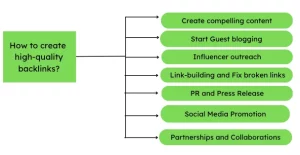
- Create Compelling Content: Produce valuable and engaging content that naturally attracts backlinks from other websites.
- Guest Blogging: Contribute guest posts to authoritative websites in your industry, including links to your website within the content.
- Influencer Outreach: Collaborate with industry influencers and thought leaders to secure backlinks through interviews, collaborations, or mentions.
- Resource Link Building: Create informative and valuable resources such as industry guides, whitepapers, or infographics to which other websites want to link.
- Broken Link Building: Find broken links on relevant websites and reach out to suggest replacing them with a link to your relevant content.
- Build Relationships: Cultivate relationships with other website owners, bloggers, and industry professionals to increase opportunities for link-building.
- Social Media Promotion: Promote your content on social media platforms to increase its visibility and encourage others to share and link to it.
- Monitor Brand Mentions: Keep track of mentions of your brand online and reach out to website owners who mention your brand without linking, asking them to include a link.
- Partner with Industry Associations or Organisations: Collaborate with industry associations, organisations, or local business directories to obtain authoritative backlinks.
- Monitor Competitor Backlinks: Analyse your competitors’ backlink profiles and identify opportunities to acquire similar high-quality backlinks.
- PR and Press Releases: Distribute press releases about significant company events or announcements, which may attract media coverage and backlinks.
- Testimonials and Reviews: Provide testimonials or reviews for products or services you have used, often including a link to your website.
Optimise for Local SEO
Optimise your website for local search if your enterprise has physical locations. Create and optimise Google My Business listings, include location-specific keywords, and encourage customer reviews to improve local search visibility.
Some tips for enterprises to optimise for local SEO:
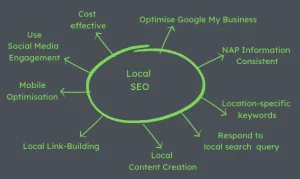
- Claim and Optimise Google My Business: Claim your business listing on Google My Business and optimise it with accurate information, including your business name, address, phone number, and website URL.
- Consistent NAP Information: Ensure consistent and accurate NAP (Name, Address, Phone Number) information across all online directories and listings.
- Local Keyword Research: Research and incorporate local keywords relevant to your business and location into your website content, meta tags, and headings.
- Location-Specific Landing Pages: Create dedicated landing pages for each location you serve, optimising them with location-specific keywords and content.
- Online Reviews and Ratings: Encourage customers to leave reviews on platforms like Google, Yelp, and industry-specific review sites. Respond to positive and negative reviews to show engagement and build trust.
- Use Local Citations: Build local citations by getting listed on relevant online directories, such as Yelp, Yellow Pages, and local business directories.
- Schema Markup: Implement schema markup on your website to provide search engines with localised information, such as an address, opening hours, and reviews.
- Local Content Creation: Develop content relevant to your local audience, such as blog posts or articles featuring local events, news, or community involvement.
- Local Link Building: Seek backlinks from local organisations, businesses, and influencers to improve your website’s local authority.
- Mobile Optimization: Ensure your website is mobile-friendly and provides a seamless experience for users accessing your site from mobile devices.
- Local Social Media Engagement: Engage with the community on social media platforms, share local news and events, and actively respond to comments and inquiries.
- Monitor and Respond to Local Search Queries: Keep track of local search queries related to your business and respond promptly to any inquiries or questions from local users.
Monitor and Analyse SEO Performance
Utilise web analytics tools to track important SEO metrics such as organic traffic, keyword rankings, bounce rates, and conversion rates. Analyse the data to identify areas for improvement and adjust your SEO strategies accordingly.
Here are some key tips on how you should monitor and analyse the SEO performance of your enterprises:
- Use Web Analytics Tools: Implement tools like Google Analytics to track and measure key metrics, including organic traffic, bounce rate, average session duration, and goal completions.
- Track Keyword Rankings: Monitor the rankings of your target keywords using tools like SEMrush, Ahrefs, or Moz. Keep track of keyword position changes over time to evaluate the effectiveness of your SEO strategies.
- Analyse Organic Traffic: Regularly review the organic traffic patterns to your website. Identify trends, spikes, or drops in traffic and correlate them with SEO activities or algorithm updates.
- Monitor Backlink Profile: Keep an eye on your backlink profile using tools like Ahrefs or Majestic. Analyse the quality and quantity of backlinks, identify any toxic or spammy links, and actively work on building high-quality backlinks.
- Track On-Site Metrics: Analyze on-site metrics such as page load speed, time on page, and bounce rate. Identify areas for improvement to enhance user experience and engagement.
- Conduct Competitor Analysis: Monitor your competitors’ SEO performance to gain insights into their strategies. Analyze their keyword rankings, backlink profiles, and content strategies to identify opportunities and stay competitive.
- Use SEO Auditing Tools: Conduct regular SEO audits using tools like Screaming Frog or Sitebulb to identify technical issues, broken links, duplicate content, or other on-page optimization opportunities.
- Monitor Social Signals: Track the impact of social media on your SEO efforts. Analyze the engagement and visibility of your content on social platforms and identify opportunities for further optimization and promotion.
- Regularly Review Search Console Data: Utilize Google Search Console to monitor website performance, indexation status, crawl errors, and search queries. Identify and address any issues that may affect your SEO performance.
- Generate Custom Reports: Create customised reports highlighting key metrics and performance indicators aligned with your business goals. Regularly review and share these reports with stakeholders to demonstrate the impact of SEO efforts.
Stay Up-to-Date with Algorithm Changes:
Keep yourself informed about search engine algorithm updates and adapt your SEO strategies accordingly. Stay updated with industry trends, attend conferences or webinars, and follow reputable SEO resources to stay ahead of the curve.
You can use these tips to stay up to date with algorithm changes:
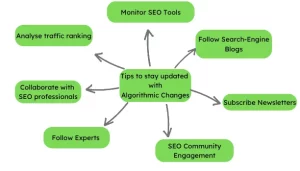
- Follow Search Engine Blogs: Keep an eye on official blogs and announcements from search engines like Google, Bing, and others. They often release updates and provide insights into algorithm changes and best practices.
- Subscribe to Industry Newsletters: Subscribe to reputable SEO newsletters and industry publications that regularly share updates and insights about algorithm changes. Examples include Moz, Search Engine Journal, and Search Engine Land.
- Engage in SEO Communities: Join online forums, discussion groups, and social media communities focused on SEO. Participate in discussions, ask questions, and learn from the experiences and insights of industry professionals.
- Attend SEO Conferences and Events: Attend conferences, webinars, and seminars dedicated to SEO. These events often feature presentations and discussions on the latest algorithm updates and strategies.
- Follow SEO Experts: Follow and engage with renowned SEO experts and influencers on social media platforms. They often share timely updates, insights, and analyses of algorithm changes.
- Monitor SEO Tools and Software: Monitor SEO tools and platforms that provide regular updates and alerts about algorithm changes. These tools may also offer analysis and recommendations to adapt to the latest updates.
- Analyse Traffic and Ranking Fluctuations: Regularly monitor your website’s traffic and keyword rankings. Sudden fluctuations could indicate algorithm updates, prompting further investigation and adjustment of your SEO strategies.
- Stay Informed about Core Updates: Major search engines occasionally roll out core updates that can significantly impact search results. Stay informed about these updates and analyse how they may affect your website’s visibility and rankings.
- Experiment and Test: Continuously experiment with different SEO strategies and tactics. Test the impact of changes on your website’s performance, rankings, and user experience to adapt to algorithm changes effectively.
- Collaborate with SEO Professionals: If resources allow, consider collaborating with experienced SEO professionals or agencies who specialise in staying updated with algorithm changes and can provide tailored recommendations for your enterprise.
Collaborate Across Teams:
In large-scale enterprises, effective SEO implementation requires collaboration between marketing, development, and content teams. Foster communication, set clear objectives, and establish a cohesive SEO strategy that aligns with the overall business goals.
This is how you can collaborate across teams for improving enterprise SEO:
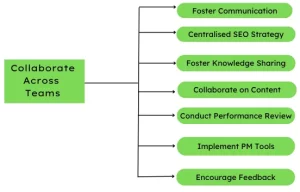
- Foster Communication and Collaboration: Encourage regular communication and collaboration among teams involved in SEO, such as marketing, content, web development, and IT. Facilitate meetings, brainstorming sessions, and knowledge sharing to exchange ideas and insights.
- Create a Cross-Functional SEO Team: Form a cross-functional SEO team comprising members from different departments to oversee and coordinate SEO efforts. This team can include representatives from marketing, content, web development, analytics, and other relevant areas.
- Develop a Centralised SEO Strategy: Collaboratively develop a centralised SEO strategy that aligns with the overall business goals. Involve stakeholders from various teams to ensure a comprehensive and integrated approach.
- Assign Roles and Responsibilities: Clearly define the roles and responsibilities of each team member involved in SEO. Establish accountability and ensure that everyone understands their specific tasks and contributions.
- Implement Regular SEO Training: Conduct regular SEO training sessions to educate teams about the fundamentals of SEO, best practices, and industry updates. This empowers teams to make informed decisions and contribute effectively.
- Foster Knowledge Sharing: Encourage knowledge sharing by creating a centralised repository or platform where teams can share insights, case studies, and successful SEO practices. This promotes cross-team learning and collaboration.
- Establish Standardised SEO Guidelines: Develop and communicate standardised SEO guidelines and best practices across teams. These guidelines should cover keyword usage, on-page optimization, content creation, and link building.
- Collaborate on Content Creation: Involve content creators, marketers, and SEO experts in the content creation process. Ensure content is optimised for target keywords, user intent, and SEO best practices.
- Conduct Regular Performance Reviews: Monitor and review SEO performance regularly, analysing key metrics and outcomes. Share performance reports with relevant teams, celebrate successes and identify areas for improvement.
- Implement Project Management Tools: Utilise project management tools and collaboration platforms to streamline communication, track tasks, and manage SEO projects across teams.
- Encourage Feedback and Idea Sharing: Create an environment that encourages teams to provide feedback, share ideas, and suggest improvements for SEO initiatives. Foster a culture of continuous improvement and innovation.
Enterprise SEO Example
One example of an enterprise that has successfully implemented SEO strategies is Nike. Nike is a global brand known for its athletic footwear, apparel, and equipment.
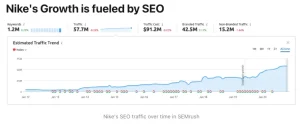
Here’s how Nike utilises enterprise SEO:
- Comprehensive Keyword Optimization: Nike conducts extensive keyword research to identify relevant search terms and incorporates them strategically across their website. They optimise their product pages, category pages, and blog content with targeted keywords to improve their organic search visibility.
- Content Strategy: Nike produces high-quality, engaging content that resonates with its target audience. They create informative blog posts, videos, and interactive experiences that provide value to users and attract organic traffic and backlinks.
- Mobile Optimization: Nike recognizes the importance of mobile-friendly experiences and ensures their website is optimised for mobile devices. They provide a seamless and user-friendly mobile experience, enabling customers to browse and shop on their smartphones and tablets.
- Localised SEO: Nike employs localised SEO strategies to target specific regions and markets. They create localised landing pages, optimise their store locator, and use location-specific keywords to attract customers at a local level.
- User Experience: Nike prioritises user experience by focusing on website speed, intuitive navigation, and engaging visuals. They optimise their website structure, implement effective navigation menus, and provide a smooth browsing experience to enhance user satisfaction.
- Influencer Collaborations: Nike collaborates with influential athletes, celebrities, and social media influencers to expand their brand reach and generate buzz. These collaborations often increase brand visibility, social media engagement, and valuable backlinks.
- Social Media Optimization: Nike leverages social media platforms to engage with their audience, share compelling content, and drive traffic to their website. They optimise their social media profiles, use relevant hashtags, and encourage user-generated content to amplify their online presence.
- E-commerce Optimization: Nike ensures their e-commerce platform is optimised for search engines. They implement structured data markup, optimise product descriptions and metadata, and streamline checkout to improve conversions and drive revenue.
- Brand Reputation Management: Nike actively manages its online reputation by monitoring brand mentions, responding to customer reviews and feedback, and addressing negative sentiment. This proactive approach helps them maintain a positive brand image in search results.
Conclusion
Implementing effective enterprise SEO strategies is crucial for businesses looking to succeed online and maximise their digital presence. By optimising website structure, conducting thorough keyword research, creating high-quality content, and staying updated with algorithm changes, enterprises can improve their search engine rankings, increase organic traffic, and generate valuable leads.
If you’re seeking expert assistance in driving your enterprise SEO efforts to new heights, connect with us. We are a trusted provider of enterprise SEO services. Visit our website today to learn more and take your enterprise SEO to the next level.
FAQ
What sets enterprise SEO apart from traditional SEO strategies?
Enterprise SEO involves optimising websites and online presence for large-scale businesses that operate nationally or globally. It requires addressing complex technical challenges, managing vast content, and implementing strategies to target multiple locations or languages. Unlike traditional SEO, enterprise SEO focuses on scalability, team coordination, and aligning SEO efforts with overall business objectives.
How long does it take to see results with enterprise SEO?
The timeline for seeing results with enterprise SEO can vary depending on various factors, such as the industry’s competitiveness, the website’s size, the existing optimization level, and the resources allocated to SEO. Generally, it takes several months to start observing significant improvements in organic rankings and traffic. However, it’s important to note that enterprise SEO is an ongoing process that requires continuous efforts and adaptation to stay ahead in the ever-evolving search landscape.
What are the critical challenges faced in enterprise SEO solutions implementation?
Enterprise SEO implementation can come with unique challenges, including coordinating efforts across multiple departments and teams, ensuring consistency and optimization of a large content volume, managing the technical complexities of a large website, and navigating organisational hierarchies and decision-making processes. It requires strong collaboration, effective communication, and a strategic approach to overcome these challenges and achieve desired SEO outcomes.
Also Read – Search Engine Optimization (SEO) Starter Guide

